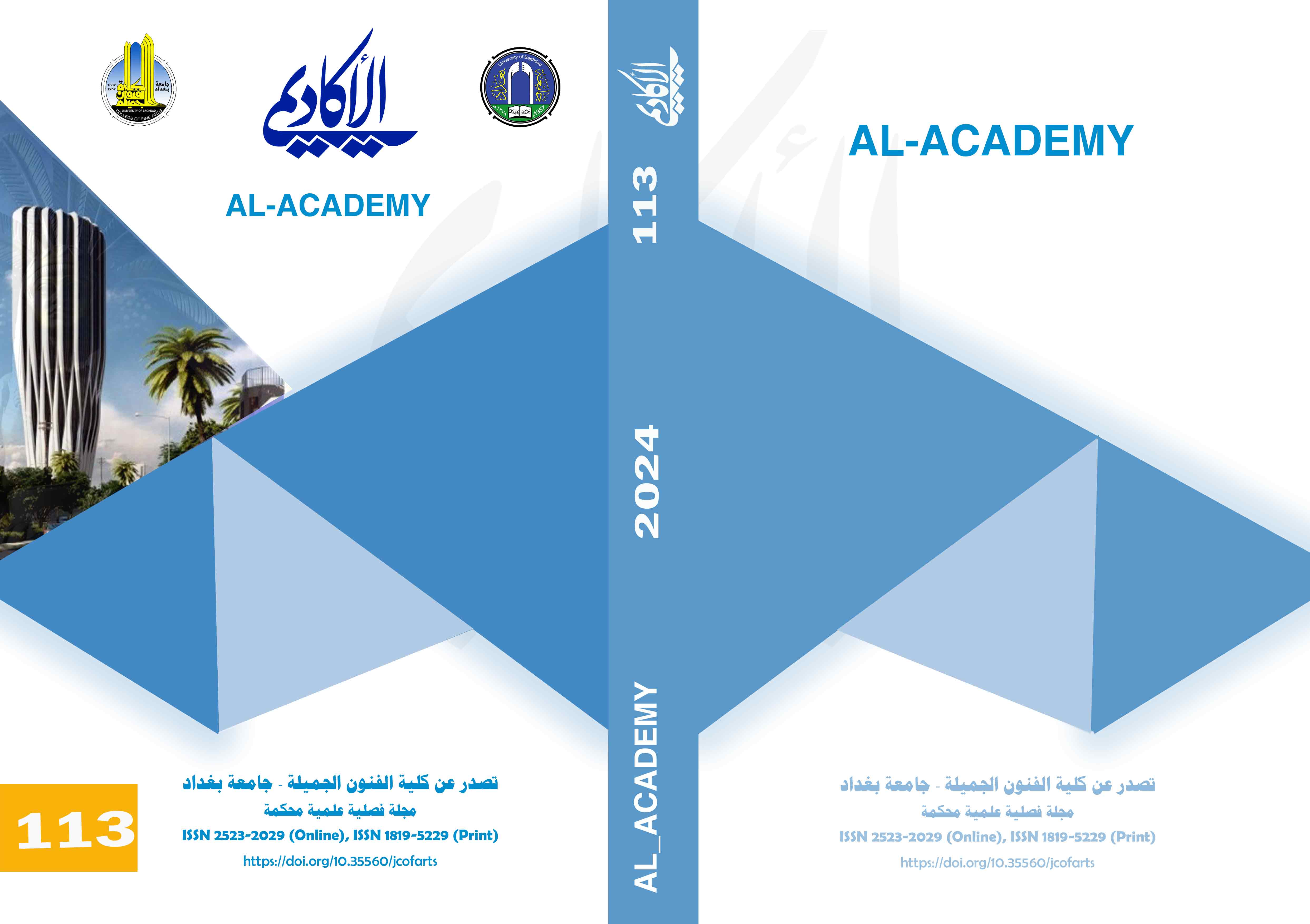Artistic layout and methods of using technology in the feature film
DOI:
https://doi.org/10.35560/jcofarts1308Keywords:
Layout, technology, Narrative film, Cinema,TechnicaAbstract
Cinema is considered an art and creativity, in addition to being an industry in its own right. It is formed thanks to techniques that contribute to the creation of reality and imagination, to employing another form of logical perceptions when they have a direct presence, in addition to the possibility of this art to form public opinion about the phenomena surrounding us and how to deal with them, as well as building bridges. Communication between art and society. Cinema has also proven throughout its stages of development that it is capable of creating positive mental images by communicating with developments in technology. Accordingly, the researcher defined the title of his research: “The Artistic Style and Methods of Using Technology in the Feature Film” and presented it in four chapters. The first is the methodological framework, including the problem? What are the requirements for using technology in making a feature film? The importance of the research lies in the diversity of the use of the artistic style as a process of organizing the methods of using technology that accompanied the making of the narrative film. One of the objectives of the research is to reveal the processes of organizing the methods of technological diversity in creating forms and models in the narrative film, and the terms that were diagnosed in the keywords, and the second chapter, the theoretical framework, was prepared in three. The first topics are the artistic style as a marking system in the feature film, the second is methods for using the artistic style in the feature film, the third is the methods of using technology in the feature film, the third chapter is the research tool, the researcher followed the descriptive and analytical method, and the fourth chapter is the results and conclusions, among which technology contributes to expanding the circle of searching for new things. In the field of techniques to improve the quality of narrative films, the quality of production in narrative films is controlled by the channels of communication and communication, including technological techniques, and their dealings with the elements of cinematic language in their narrative and artistic context in continuous harmony to achieve the goal and means of how to make narrative films.
References
- Al-Razi. Muhammad bin Abi Bakr bin Abdul Qadir (2007) Mukhtar Al-Sahah, 2nd edition, Beirut, Dar Al-Ma’rifa.
- Ibn Manzur (2003). Lisan Al-Arab, Dar Sader, Beirut, Lebanon.
- A bird. Jaber (1993). Kuwait, Dar Suad Al-Sabah.
- Giorno. Marie-Thérèse (2007) Dictionary of Cinema Terms, Translated by: Fayez Bashour, Syria, Damascus, General Cinema Establishment.
- Al-Bashlawi. Khairiya (2004) Dictionary of Cinematic Terms, Translated by:
- Hopes. Bou Chashou and Hamdaoui Saida (2021) Semiotics of the Narrative Film, Algeria, Larbi Ben Mhidi University Oum El Bouaghi, Faculty of Arts, Department of Arabic Language and Literature.
- Sabti. Obaida (2009) Najib Bakhoush, Introduction to Semiology, Dar Al-Khaldouniya.
- Lahmidani. Hamid (1991) The Structure of Narrative Text, Beirut, Arab Cultural Center for Printing, Publishing and Distribution. Pryor.
- Pryor. Mary Nawal Gary (2 018) Key Terms in Linguistics, Algeria, translated by Abdelkader Fahim Al-Shaibani, Sidi Bel Abbes.
- Al-Salman Hussein (2006) On the Aesthetic Hypothesis of Cinema, Baghdad, House of General Cultural Affairs.
- Jacobson Roman (1963). Studies in General Linguistics, Baghdad, Ministry of Culture Publications.
2- Jassim. Aladdin Abdel Majeed (2010), The Constant and the Transformable in Cinematic Creativity, Baghdad, University of Baghdad, Journal of the College of Arts, Issue 93.
-Hussein Ihsan Nasser. And Jassim Hussein Sultan Al-Khalidi (2022), the textual interrelationship between novel and cinema... the novels that won the Arab Booker Prize (2008 - 2018) as a model., Wasit University, College of Education for Human Sciences.
- Rom. Michael (1981). Conversations about film directing, by: Adnan Madanat, Beirut/Dar Al-Farabi.
- Youssef. Yuev, (2022) Nizwa Magazine, a quarterly cultural magazine issued by the Ministry of Information, Issue - 10, Muscat, Sultanate of Oman, article - Novel and Film.
6 - Riyad Abdel Fattah (1973) Training in Plastic Arts, Cairo, Dar Al Nahda Al Arabiya.
- Lumet, Sidney (2006). The Art of Efkhraj Cinema, Translated by: Ahmed Youssef, Cairo, National Center for Translation.
- Bazin, Andrea (1968. What is Cinema, Part 2, The Origins of Cinema and Its Language, Trans. Raymond Francis, Cairo, Franklin Printing and Publishing Corporation.
- Abbas, Rawya Abdel Moneim (1087), Aesthetic Values, Alexandria, Dar Al-Ma’rif University.
- Ali, Heba Ibrahim Sayed (2018) Digital technology in the design of virtual cinematography locations, Architecture and Arts Magazine, Issue 10, Part 2
- Zidane Ashraf Muhammad and Saif Al-Suwaidi, (2022). The World Beyond the Conventional (Meta Virus), Turkey, Istanbul, Dar Al-Asala for Medicine, Publishing and Distribution, 2nd edition.
- Al-Qaisi, Fares Mahdi (2012) Digital Technology in Film and Television Production, Baghdad, Al-Academy Magazine - Issue 47.
- Al-Mahdi Marwa Abdel Latif and Manal Hilal Ayoub, (2013) Helwan University, Faculty of Applied Arts, computer technology and sculptural objects and their impact on embodying dramatic reality in cinematic films.
Downloads
Published
Issue
Section
License
Copyright (c) 2024 Abdel Nasser Mustafa Ibrahim

This work is licensed under a Creative Commons Attribution 4.0 International License.













